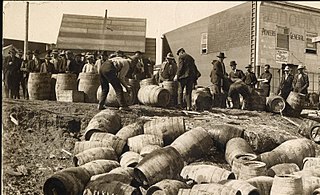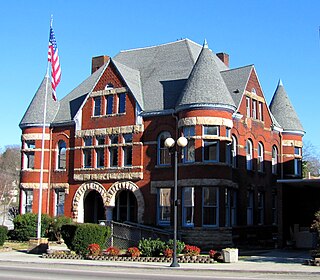Related Research Articles

Prohibition is the act or practice of forbidding something by law; more particularly the term refers to the banning of the manufacture, storage, transportation, sale, possession, and consumption of alcoholic beverages. The word is also used to refer to a period of time during which such bans are enforced.

The Eighteenth Amendment of the United States Constitution established the prohibition of alcohol in the United States. The amendment was proposed by Congress on December 18, 1917, and was ratified by the requisite number of states on January 16, 1919. The Eighteenth Amendment was repealed by the Twenty-first Amendment on December 5, 1933. It is the only amendment to be repealed.

The Twenty-first Amendment to the United States Constitution repealed the Eighteenth Amendment to the United States Constitution, which had mandated nationwide prohibition on alcohol. The Twenty-first Amendment was proposed by the 72nd Congress on February 20, 1933, and was ratified by the requisite number of states on December 5, 1933. It is unique among the 27 amendments of the U.S. Constitution for being the only one to repeal a prior amendment, as well as being the only amendment to have been ratified by state ratifying conventions.

The temperance movement is a social movement against the consumption of alcoholic beverages. Participants in the movement typically criticize alcohol intoxication or promote complete abstinence from alcohol (teetotalism), and its leaders emphasize alcohol's negative effects on people's health, personalities and family lives. Typically the movement promotes alcohol education and it also demands the passage of new laws against the sale of alcohol, either regulations on the availability of alcohol, or the complete prohibition of it. During the 19th and early 20th centuries, the temperance movement became prominent in many countries, particularly in English-speaking, Scandinavian, and majority Protestant ones, and it eventually led to national prohibitions in Canada, in Norway and in the United States, as well as provincial prohibition in India. A number of temperance organizations exist that promote temperance and teetotalism as a virtue.
The Woman's Christian Temperance Union (WCTU) is an active international temperance organization that was among the first organizations of women devoted to social reform with a program that "linked the religious and the secular through concerted and far-reaching reform strategies based on applied Christianity." It plays an influential role in the temperance movement. The organization supported the 18th Amendment and was also influential in social reform issues that came to prominence in the progressive era.

Harriman is a city located primarily in Roane County, Tennessee, with a small extension into Morgan County. The population of Harriman was 6,350 at the time of the 2010 census.
Alcoholic beverage control states, generally called control states, less often ABC states, are 17 states in the United States that, as of 2016, have state monopoly over the wholesaling or retailing of some or all categories of alcoholic beverages, such as beer, wine, and distilled spirits.

José Darío Argüello (1753–1828) was a Querétaro-born Californio politician, soldier, and ranchero. He served as interim Governor of Alta California and then a term as Governor of Baja California.

Prohibition in Canada was a ban on alcoholic beverages that arose in various stages, from local municipal bans in the late 19th century, to provincial bans in the early 20th century, and national prohibition from 1918 to 1920. The relatively large and powerful beer and alcohol manufacturing sector, and the huge working class that purchased their products, failed to convince any of the governments to reverse their stance on prohibition. Most provinces repealed their bans in the 1920s, though alcohol was illegal in Prince Edward Island from 1901 to 1948. By comparison, Ontario's temperance act was in effect from 1916 to 1927.
Ewing Young was an American fur trapper and trader from Tennessee who traveled in what was then the northern Mexico frontier territories of Santa Fe de Nuevo México and Alta California before settling in the Oregon Country. Young traded along the Santa Fe Trail, followed parts of the Old Spanish Trail west, and established new trails. He later moved north to the Willamette Valley. As a prominent and wealthy citizen in Oregon, his death was the impetus for the assemblies that several years later established the Provisional Government of Oregon.

Alcohol laws are laws in relation to the manufacture, use, being under the influence of and sale of alcohol or alcoholic beverages that contains ethanol. Common alcoholic beverages include beer, wine, (hard) cider, and distilled spirits. The United States defines an alcoholic beverage as "any beverage in liquid form which contains not less than one-half of one percent of alcohol by volume", but this definition varies internationally. These laws can restrict those who can produce alcohol, those who can buy it, when one can buy it, labelling and advertising, the types of alcoholic beverage that can be sold, where one can consume it, what activities are prohibited while intoxicated, and where one can buy it. In some cases, laws have even prohibited the use and sale of alcohol entirely, as with Prohibition in the United States from 1920 to 1933.

The Hartford Baptist Church is located on Main Street in Hartford, New York, United States. It is a brick church with tall wooden bell tower built in the late 19th century on the same site as the congregation's original 1789 church on land deeded to it by Dewitt Clinton, the fourth of its churches to occupy the site. Designed by Philadelphia architect Benjamin Price, it is the only Victorian Gothic church in the town, and one of a few in the county. Next to the church is a cemetery with almost two centuries of graves, including those of early Hartford settlers and some Revolutionary War veterans.

Prohibition Park, also called National Prohibition Park, was a temperance town and park used as a summer colony in the New York City borough of Staten Island, precursor to the modern Westerleigh neighborhood. The park and community were founded after the purchase of the land in 1887 by members of the National Prohibition Party during a temperance movement prior to Federal prohibition in the United States, with the specification that no consumption of alcohol would be permitted in the area. At its peak the park had extended nearly 150 acres, but declined in the 1900s along with the temperance movement, with much of the land sold to non-movement members. The remaining parkland was obtained by the City in 1907, surviving as Westerleigh Park and Northerleigh Park operated by the New York City Parks Department.

DeMoss Springs Park is a park located near Moro, Oregon listed on the National Register of Historic Places. The site was once the settlement of the DeMoss family, a noted family singing group that toured as the DeMoss Lyric Bards during the period 1872-1912. The family donated the land to the county as a park in 1897.

The Temperance movement in the United States is a movement to curb the consumption of alcohol. It had a large influence on American politics and American society in the nineteenth and twentieth centuries, culminating in the unsuccessful prohibition of alcohol, through the Eighteenth Amendment to the United States Constitution, from 1920 to 1933. Today, there are organizations that continue to promote the cause of temperance.
The temperance movement in the United Kingdom was a social movement that campaigned against the recreational use and sale of alcohol, and promoted total abstinence (teetotalism). In the 19th century, high levels of alcohol consumption and drunkenness were seen by social reformers as a danger to society's wellbeing, leading to social issues such as poverty, child neglect, immorality and economic decline. Temperance societies began to be formed in the 1830s to campaign against alcohol. Specific groups were created over periods of time dedicated to the different aspects of drinking. For example, in 1847, the Band of Hope was created to persuade children not to start drinking alcohol. Most of these temperance groups were aimed at the working class. Temperance was also supported by some religious groups, particularly the Nonconformist Churches. Although the temperance movement met with local success in parts of Britain, it failed to impose national prohibition, and disappeared as a significant force following the Second World War.
Harriet Duncan Hobart (1825–1898) was an American schoolteacher and women's rights advocate. After teaching in New York City, she came to Minnesota in 1868 and became an advocate for temperance and women's suffrage. She was president of the Minnesota Woman's Christian Temperance Union (WCTU) for seventeen years and urged the WCTU to work on behalf of women's rights more broadly.

De Moss Springs is an unincorporated community in Sherman County, in the U.S. state of Oregon. It is about 3 miles (5 km) northeast of Moro along U.S. Route 97.
References
- ↑ Susanna Barrows and Robin Room, Puritans in Taverns: Law and Popular Culture in Colonial Massachusetts, 1630–1720, p. 185, University of California Press (April 1991)
- ↑ Walter T. Pulliam, Harriman, the Town that Temperance Built, 706pp, (privately printed by Pulliam, 1978)
- ↑ Neill, Edward Duffield; Minneapolis, North star publishing company (July 30, 1882). History of the Minnesota Valley: Including the Explorers and Pioneers of Minnesota. North star publishing Company. p. 480 – via Internet Archive.
cleveland.
- ↑ "The Reform Bulletin: A Weekly Report from the New York Legislature, Concerning the Progress of All Moral Reforms Before that Body". O.R. Miller. July 30, 1910 – via Google Books.
- ↑ Aug 03, Michael Redmon Wed; 2016 | 12:00am (2016-08-03). "The Founding of Lompoc". The Santa Barbara Independent. Retrieved 2020-05-10.
- ↑ Record, Dennis Headrick 77 Special To The. "A local liquor legend from a time long past". Lompoc Record. Retrieved 2020-05-10.